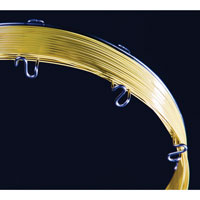
01494 563377
Rt-Alumina BOND/MAPD
Product Code: 19778
Description
Restek Rt®-Alumina BOND columns are highly selective for C1–C5 hydrocarbons and separate all unsaturated hydrocarbon isomers above ambient temperatures. The reactivity of the aluminum oxide stationary phase is minimized to improve column response for polar unsaturates, such as dienes, and the columns’ sensitivity (or response) ensures linear and quantitative chromatographic analysis for these compounds. Strong bonding prevents particle generation and release to allow valve switching without harming the injection or detection systems. And because they are stable up to at least 200 °C, Rt®-Alumina BOND columns can be regenerated to restore full efficiency and selectivity if water is adsorbed by conditioning at their maximum temperature. High capacity and loadability give you exceptionally symmetric peaks, making these columns ideal for volatile hydrocarbon separations at percent levels, as well as impurity analyses at ppm concentrations. Restek Rt®-Alumina BOND PLOT columns are manufactured on fused silica tubing; select phases are also available on metal MXT® tubing.
Guaranteed Reproducibility
To ensure reproducible retention times and predictable flow behavior column-to-column, each Rt®-Alumina BOND column is extensively tested. A hydrocarbon test mix confirms proper phase retention and selectivity. To calculate k (capacity factor), which is a measure of phase retention, 1,3-butadiene is used, while selectivity is measured using retention indices for propadiene and methyl acetylene. The resolution of trans-2-butene and 1-butene is also verified, and to measure efficiency, plates per meter are checked using 1,3-butadiene.
- Optimized deactivation produces maximum response when analyzing trace levels of acetylene, methyl acetylene, and propadiene.
- Stable response factors make this column ideal for process-type applications where recalibration must be minimized.
- High loadability reduces peak tailing and improves separations.
- Extended temperature range up to 250 °C for fast elution of high molecular weight (HMW) hydrocarbons and accelerated column regeneration following exposure to water.
Restek's R&D chemists have optimized the deactivation technology applied to our Rt®-Alumina BOND/MAPD column for improved analysis of trace concentrations of polar hydrocarbons like acetylene, methyl acetylene, and propadiene in hydrocarbon streams containing higher levels of C1-C5 hydrocarbons. Our new Alumina PLOT deactivation produces an incredibly inert column that offers superior reproducibility and stable response factors to maximize the number of analyses before recalibration is required. Its high sample capacity reduces peak tailing, thereby improving the separation of target compounds. In addition, a 250 °C maximum operating temperature lets you more quickly elute hydrocarbons up to dodecane and reduces regeneration time when the column is exposed to water from samples or carrier gases.



